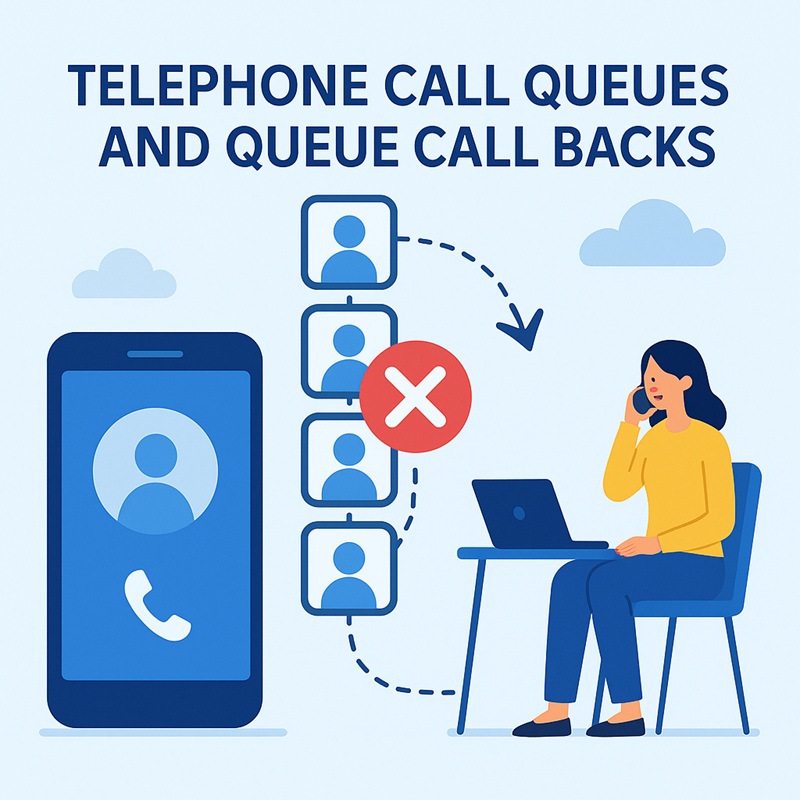What is a Call Queue?
A call queue functions as a virtual waiting line for callers when agents are busy. Instead of encountering a busy tone or voicemail, callers are placed into a structured queue and connected once an agent is available. During this wait, they may hear estimated position updates, comfort messages, promotional content—or music tailored to your brand.
Managing high volumes of incoming calls can be a challenge—but with the right technology, it becomes an opportunity. Call Queues and Queue Call Backs not only enhance efficiency but also elevate customer satisfaction.
Key benefits include:
- Efficient traffic management: Automates distribution of calls, reducing idle and overloaded time across agents.
- Reduced abandonment: Informing callers of position and wait time keeps them engaged.
- Brand professionalism: Custom greetings, on-hold messages, and briefing content showcase your identity.
- Data-driven insights: Real‑time dashboards and reporting support continuous improvement in queue performance.
- Improved call resolution: Coupled with intelligent routing, call queues increase First Call Resolution (FCR) rates.
How Queue Call Backs Work
Queue Call Backs let customers keep their place and hang up—only to receive a return call when an agent is free. Most systems offer this when wait times exceed a configurable threshold.
Typical call flow:
- Call arrives; queue is busy
- IVR offers callback option
- Caller opts in and hangs up
- System retains queue position and number
- When an caller is next in the queue the system calls the customer back automatically.
Why Offer Queue Call Backs?
- Significantly Reduced Call Abandonment - Callback availability reduces dropped calls — customers don’t need to wait on hold and hang up out of frustration.
- Enhanced Customer Satisfaction - Enabling a callback demonstrates that you value their time—driving satisfaction, trust and loyalty.
- Smarter Agent Engagement - Callbacks give agents a manageable call rhythm, reducing stress and improving quality of service.
- Lower Operational Costs - On-hold minutes are eliminated—causing savings in telecom charges and capacity usage during busy periods.
- Stronger First Call Resolution (FCR) - With customers relaxed and agents prepared, queries are more likely to be resolved in the first interaction—fewer callbacks, fewer escalations.
Best Practice
- Threshold settings: Offer callbacks only when wait times exceed a certain length—e.g., after 60 seconds. Don’t offer callback if wait is short.
- Transparent messaging: Clearly communicate the estimated callback time and how requests are queued.
- Retry logic: If the customer doesn’t answer, automatically retry a safe number of times. We retry 3 times.
- Visibility options: Choose between visible or invisible queues depending on whether callbacks should appear alongside regular queued calls.
Why Combine Call Queues with Call Backs?
Integrating both ensures peak performance in service and operations. Call queues provide structure, while queue callbacks offer flexibility—together they minimise lost calls, relieve wait-related frustration, and uphold a polished, customer‑first image.
For businesses handling support enquiries, sales calls, or service lines, these tools elevate both caller experience and staff productivity—without adding cost or complexity.
Final Thoughts
Call Queues and Queue Call Backs reflect modern telephony best practice. They:
- Slash abandon rates
- Boost customer satisfaction
- Improve staff effectiveness
- Enhance operational efficiency
If you're aiming to handle inbound calls with professionalism and precision, adopting these technologies is the way forward.
Contact us to learn how Call Queues and Call Backs can elevate your inbound calling experience.
